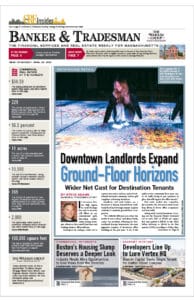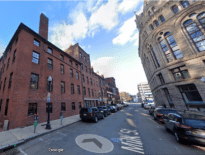Sometimes crisis creates opportunity. In the case of downtown Boston, the real estate industry and both city and state political leadership have a chance to come together and create a new and better economic engine room for Massachusetts.
As a report released last week by the Massachusetts Taxpayers Foundation shows, downtown’s troubles are no passing storm. It’s afflicted by the same problems of high office vacancy rates and plateauing foot traffic that are hitting all of Boston’s peer cities in this country – only because Boston’s downtown has so heavily tilted towards office uses, we’re in a noticeably worse position.
You could summarize the state of things with one statistic: cell phone location data collected by the University of Toronto’s School of Cities. While the MTF report cites figures as they evolved from 2019 to 2023, May 2024 data shows only 47 percent to 49 percent as many workers, visitors and tourists went downtown than before the pandemic, a figure that’s been largely static, and has even declined slightly, since the summer of 2022.
Compare that to 75 percent in Washington, D.C., 67 percent in New York City and 62 percent in Miami. Even infamously sprawling and car-centric Los Angeles’ downtown has 64 percent of its downtown foot traffic back. Most importantly, many other American metros, including New York and D.C., are still recording a steady upward trend.
This Is No Passing Storm
As everyone knows all too well by now, downtown Boston’s overall office vacancy rate has hit 23 percent according to Colliers research, the highest in 40 years, and the state of affairs in the class B and C markets is much worse. Because commercial property values are driven by how much rental income a building generates, this state of affairs is also set to hammer city tax revenue as building owner after building owner applies for tax abatements or simply sells at market prices that seem to be settling in at roughly 30 percent off their pre-pandemic levels.
With Boston’s budget so heavily dependent on commercial property taxes, any political or civic leader inclined to ignore these facts and hope for spontaneous, immaculate revival is living dangerously distant from reality.
Experts told the real estate community at an industry forum this month that vacancy numbers like that will take 10 years or more to come down to a more manageable level. We don’t have the luxury to wait around for the downtown ship to right itself.
As the disappointing results of Boston Mayor Michelle Wu’s admirable office-to-residential conversion incentive show, this crisis demands both fiscal and policy firepower beyond the city’s means. Without a deeper pool of subsidies available, the pilot looks likely to sunset with only four conversions proposed in downtown proper that together will knock less than 100 basis points off the city’s class B and C office vacancy rate, plus five small projects in other neighborhoods.
Plenty of building owners want to make renovations to their vacant or semi-vacant properties so they can “earn the commute” from potential office tenants, or convert to other uses like housing and hotels. But they simply can’t afford the interest rate on the loans to pay for it thanks to the Federal Reserve, especially if their property tax rates go up as the mayor and city councilors propose.
And outside of a commercial foreclosure wave – a looming possibility that’s getting more likely the longer policymakers wait to come up with solutions – selling out is a bad play, too. The huge drop in downtown Boston commercial values, totaling over $32 billion as of December 2022 according to academic research cited by MTF, means building owners are at risk of not only losing their shirts but defaulting on loans, as well, and putting banks at risk.
Time to Bury Hatchets
But, as the MTF report ably lays out, this issue is so big and hairy that neither state and local policymakers nor the real estate industry can adopt a myopic focus on a limited number of solutions, like office-to-residential conversions.
Everyone involved – including the lenders who hold mortgages on downtown buildings – needs to look for creative solutions, and be prepared to bury a few hatchets, abandon a cherished red line or two and offer compromises while testing out a broad range of ideas. Downtown needs a wholesale reinvention, not a few tweaks.
The good news is that some necessary ideas are already in the pipeline, from the Wu administration’s downtown rezoning plan to Gov. Maura Healey’s proposal to seed a big “climatetech” sector that will need office and research space near our most innovative universities and production facilities in our industrial Gateway Cities.
In the short term, Gov. Maura Healey and legislative leaders need to give Boston a fiscal escape hatch, either in the form of additional state aid or the power to raise limited revenue from a source other than property taxes, to dodge city leaders’ perceived need to hike commercial tax rates.
Looking out to next year, politicians and real estate leaders need to act with urgency to find durable policy solutions that can open the door to downtown’s next chapter.
Letters to the editor of 350 words or less responding to this editorial or other topics may be submitted via email at editorial@thewarrengroup.com with the subject line “Letter to the Editor.” Submission is not a guarantee of publication.
Editor’s Note 10:23 a.m. June 24, 2024: This editorial has been updated to reflect the additional filing of two more office-to-residential conversion proposals in downtown Boston.






